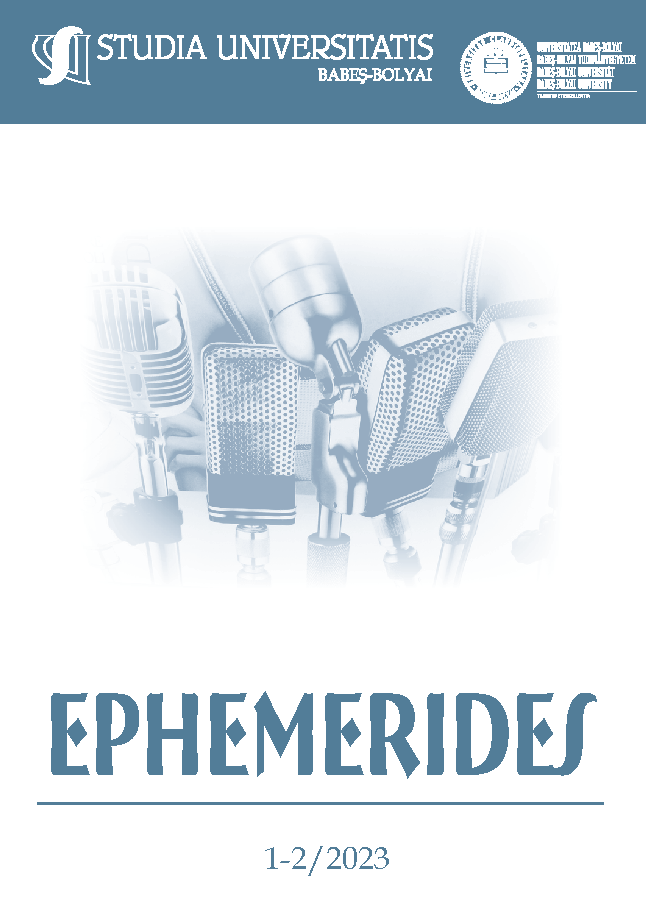Tell me your zodiac sign, I tell you who you are – Horoscopes in teen magazines. The portrayal of horoscopes in German and American teenage girl’s magazines
DOI:
https://doi.org/10.24193/subbeph.2023.01Keywords:
horoscope, astrology, zodiac sign, magazine, teenagers, cultural differences, media realityAbstract
Even though it is common knowledge that astrology is not based on scientific evidence, a lot of people seem to care about it. For example, they read their horoscope on a daily, weekly or monthly basis. One way to get easy access to horoscopes is through media such as magazines. Depending on which magazines you are reading these astrological predictions may vary. Previous studies suggest that these differences can be explained either by different target groups, which have different socio-demographic backgrounds, or by different cultural background depending on a specific geographical region. Thus, not only media in general but also specific media outlets account for creating a certain reality. Focusing on young women’s magazine – which influence the development of teenage girls who read them – this study aims to find out how horoscopes are presented in the German Bravo-Girl and in the American Teen Vogue. A textual analyse was conducted on 24 horoscopes – one for each zodiac sign and each magazine. The findings suggest that romantic relationship, friendship, feelings and self-development were the most prevalent topics, whereas money was not mentioned at all. This could be explained by the varying importance of these topic for teenagers, mostly still living at home. Unexpectedly, technology and family do not play a big role even though they are part of teenager’s everyday life. Nevertheless, there could not be found any differences between the two magazines since Germany and the USA are both considered Western cultures with similar cultural backgrounds.
References
Alfrahová, E. (2005). Zum Vorkommen von Phraseologismen in deutschen und tschechischen Horoskopen. Brünner Beiträge Zur Germanistik und Nordistik., 19, 111–128. https://hdl.handle.net/11222.digilib/105864
Allum, N. (2011). What makes some people think astrology is scientific? Science Communication, 33(3), 341–366. https://doi.org/10.1177/1075547010389819
Andersson, I., Persson, J. & Kajonius, P. (2022). Even the stars think that I am superior: personality, intelligence and belief in astrology. Personality And Individual Differences, 187, 1–3. https://doi.org/10.1016/j.paid.2021.111389
Campion, N. (2008). Horoscopes and popular culture. In B. Franklin (Hrsg.), Pulling newspapers apart. Analysing print journalism. (S. 239–246). Routledge. https://api.pageplace.de/preview/DT0400.9781134094400_A24930033/preview-9781134094400_A24930033.pdf
Carpenter, L. M. (1998). From girls into women: Scripts for sexuality and romance in seventeen magazine, 1974–1994. The Journal of Sex Research, 35(2), 158–168. https://doi.org/10.1080/00224499809551929
Davalos, D. B., Davalos, R. A. & Layton, H. S. (2007). III. Content Analysis of Magazine Headlines. Feminism & Psychology, 17(2), 250–258.
https://doi.org/10.1177/0959353507076559
Firminger, K. B. (2005). Is he boyfriend material? Men And Masculinities, 8(3), 298–308. https://doi.org/10.1177/1097184x05282074
Gille, A. S. (2014). Politische Bildung in Fotoromanen von Jugendzeitschriften. In Springer eBooks. https://doi.org/10.1007/978-3-658-05158-7
Lillqvist, O. & Lindeman, M. (1998). Belief in Astrology as a Strategy For Self-Verification and Coping With Negative Life-Events. European Psychologist, 3(3), 202–208. https://doi.org/10.1027/1016-9040.3.3.202
Liparová, A. (2022). Textsorte Horoskop im deutsch-tschechischen Vergleich. dargestellt an Jugend- und Unterhaltungspresse[BA thesis, MASARYKOVA UNIVERZITA]. https://is.muni.cz/th/z3fm4/Textsorte_Horoskop_im_deutsch-tschechischen_Vergleich._Dargestellt_an_Jugend-_und_Unterhaltungspresse_DP_Liparova.pdf
Pınarbaşı, G. (2021). Mass media and astrology as a reflection of the culture industry. Psychology Research On Education And Social Sciences, 2(2), 83–93.
Sun, L., Zhang, H., Zhang, S. & Luo, J. (2020). Content-based Analysis of the Cultural Differences between TikTok and Douyin. arXiv (Cornell University). https://doi.org/10.48550/arxiv.2011.01414
Tandoc, E. C. & Ferrucci, P. (2014). So says the stars: A textual analysis of Glamour, Essence and Teen Vogue horoscopes. Women S Studies International Forum, 45, 34–41. https://doi.org/10.1016/j.wsif.2014.05.001
t-online. (2023). Bravo Girl“ wird nach 35 Jahren eingestellt. T-online. Abgerufen am 23. Juni 14 n. Chr., von https://www.t-online.de/unterhaltung/stars/id_100185966/-bravo-girl-kultmagazin-wird-nach-35-jahren-eingestellt.html
Downloads
Published
How to Cite
Issue
Section
License
Copyright (c) 2024 Studia Universitatis Babeș-Bolyai Ephemerides

This work is licensed under a Creative Commons Attribution-NonCommercial-NoDerivatives 4.0 International License.



